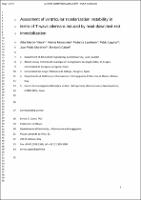Por favor, use este identificador para citar o enlazar este ítem:
https://repositorio.usj.es/handle/123456789/1061
Registro completo de metadatos
| Campo DC | Valor | Lengua/Idioma |
|---|---|---|
| dc.contributor.author | Monasterio, Violeta | - |
| dc.contributor.author | Martín-Yebra, Alba | - |
| dc.contributor.author | Landreani, Federica | - |
| dc.contributor.author | Laguna, Pablo | - |
| dc.contributor.author | Martinez, Juan Pablo | - |
| dc.contributor.author | Caiani, Enrico G. | - |
| dc.date.accessioned | 2024-01-24T12:38:06Z | - |
| dc.date.available | 2024-01-24T12:38:06Z | - |
| dc.date.issued | 2019 | - |
| dc.identifier.citation | Alba Martín-Yebra et al 2019 Physiol. Meas. 40 104001 | en_US |
| dc.identifier.issn | 0967-3334 | en_US |
| dc.identifier.uri | https://repositorio.usj.es/handle/123456789/1061 | - |
| dc.description.abstract | Objective: To assess the effects of different durations of simulated microgravity exposure on ventricular repolarization (VR) in terms of T-wave alternans (TWA) as well as to test whether an increase in VR heterogeneity could be detected once normal gravity was restored. Approach: A total of 63 healthy volunteers were recruited in several head-down bed-rest (HDBR) experiments in the context of the European Space Agency bed-rest strategy. TWA is evaluated during the night period using ambulatory ECG recordings, before, during and after long- (60 d), mid- (21 d) and short- (5 d) duration HDBR by the long-term averaging technique. Main results: 5-21 d of exposure to simulated microgravity by means of the HDBR model do not lead to a significant increase of cardiac electrical instability in healthy myocardial substrates up to the point of eliciting TWA on the surface ECG. However, TWA indices increased after long-term HDBR exposure, once normal gravity was re-established, indicative of incipient electrical instability on VR at the conclusion of 60 d of HDBR. Significance: The results of this work underline the importance of focusing future research on immediate effects after long-term microgravity exposure, both simulated by HDBR or from space mission scenarios, once partial gravity conditions are re-established. A deeper insight in the understanding of human body reactions in these scenarios results crucial in the design of future long-duration spaceflight missions, to mitigate any potential risk that can limit astronaut's performance. | en_US |
| dc.format.extent | 19 p. | en_US |
| dc.format.mimetype | application/pdf | en_US |
| dc.language.iso | eng | en_US |
| dc.publisher | IOP Publishing | en_US |
| dc.relation.requires | Adobe | en_US |
| dc.rights | Attribution-NonCommercial-NoDerivatives 4.0 Internacional | * |
| dc.rights.uri | http://creativecommons.org/licenses/by-nc-nd/4.0/ | * |
| dc.subject | Microgravity | en_US |
| dc.subject | Head-down bed-rest (HDBR) | en_US |
| dc.subject | Ventricular repvolarization | en_US |
| dc.subject | Electrocardiogram (ECG) | en_US |
| dc.subject | T wave alternans (TWA) | en_US |
| dc.subject | Cardiac arrhythmias | en_US |
| dc.title | Assessment of ventricular repolarization instability in terms of T-wave alternans induced by head-down bed-rest immobilization ( Author submitted manuscript) | en_US |
| dc.type | journal article | es_ES |
| dc.identifier.doi | 10.1088/1361-6579/ab4c18 | en_US |
| dc.rights.accessRights | open access | es_ES |
| dc.type.hasVersion | SMUR | es_ES |
| Aparece en las colecciones: | Artículos de revistas | |
Ficheros en este ítem:
| Fichero | Descripción | Tamaño | Formato | |
|---|---|---|---|---|
| Assessment of ventricular repolarization instability.pdf | 1,21 MB | Adobe PDF |  Visualizar/Abrir |
Este ítem está sujeto a una licencia Creative Commons Licencia Creative Commons

